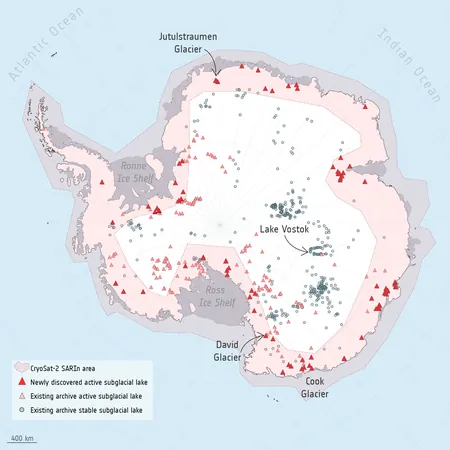
Unveiling Antarctica’s Hidden Wonders: 85 New Subglacial Lakes Discovered!
2025-09-19
Author: Sarah
Revolutionary Discovery Beneath the Ice
Deep beneath Antarctica's icy blanket lies a world of secrets, with hundreds of subglacial lakes shaping the very foundations of the continent. These hidden lakes play a pivotal role in glacier movement and stability, making them crucial to understanding global sea level changes.
A Groundbreaking Increase in Known Lakes
Thanks to a decade-long mission by the European Space Agency's CryoSat satellite, researchers have unmasked 85 previously unknown lakes buried kilometers beneath the South Pole’s frozen surface. This astounding revelation brings the total number of active subglacial lakes in Antarctica to 231, enhancing our insight into these mystical water bodies dramatically!
Understanding Subglacial Behavior
Published in Nature Communications, this research highlights the dynamic nature of these lakes, which fill and drain in cycles that reveal crucial information about the ice sheet's behavior. Lead researcher Sally Wilson from the University of Leeds emphasizes the difficulty of observing these processes, noting that only 36 complete cycles had been recorded globally before this study. Their findings add an impressive 12 more complete events to this tally.
The Amazing Role of Satellites
Satellites have bridged the gap in our understanding of these underground lakes. The CryoSat mission, launched in 2010, has offered invaluable data that tracks changes in the height of the ice surface over time, directly linked to the cycles of filling and draining of subglacial lakes. This technology allows researchers to map these hidden environments with unprecedented accuracy.
A Dynamic Hydrological System
Co-author Anna Hogg also from the University of Leeds, revealed that subglacial lake areas can fluctuate significantly during different hydrological cycles, showcasing a much more dynamic system than previously believed. With ongoing monitoring, scientists can keep pace with these changes, which is key for predicting future shifts in ice sheet behavior.
Geothermal Forces at Play
Subglacial lakes primarily form from geothermal heat from the Earth's bedrock and frictional heat from ice movement overhead. This meltwater creates pools that can drain periodically, altering how the ice slides towards the ocean, thus impacting the landscape profoundly.
Global Climate Implications
The cycles of these subglacial lakes represent a critical missing element in our understanding of ice sheets and their contribution to rising sea levels. Sally Wilson asserts that mapping the locations and activity of these lakes is vital for improving climate models and making accurate predictions about future sea level scenarios.
The Bigger Picture
The largest subglacial lake, Lake Vostok, lies beneath 4 kilometers of ice and holds roughly 5,000 to 65,000 cubic kilometers of water—enough to fill the Grand Canyon and then some! While largely stable, a drainage event here could unleash significant consequences for surrounding ecosystems and global sea levels.
A Call to Further Exploration
This remarkable discovery not only adds to our knowledge base but also underscores the necessity for continued exploration and monitoring of Antarctica’s subglacial environments. The revelations about subglacial hydrology could significantly reshape our understanding of climate change and its far-reaching impacts on life as we know it.




 Brasil (PT)
Brasil (PT)
 Canada (EN)
Canada (EN)
 Chile (ES)
Chile (ES)
 Česko (CS)
Česko (CS)
 대한민국 (KO)
대한민국 (KO)
 España (ES)
España (ES)
 France (FR)
France (FR)
 Hong Kong (EN)
Hong Kong (EN)
 Italia (IT)
Italia (IT)
 日本 (JA)
日本 (JA)
 Magyarország (HU)
Magyarország (HU)
 Norge (NO)
Norge (NO)
 Polska (PL)
Polska (PL)
 Schweiz (DE)
Schweiz (DE)
 Singapore (EN)
Singapore (EN)
 Sverige (SV)
Sverige (SV)
 Suomi (FI)
Suomi (FI)
 Türkiye (TR)
Türkiye (TR)
 الإمارات العربية المتحدة (AR)
الإمارات العربية المتحدة (AR)